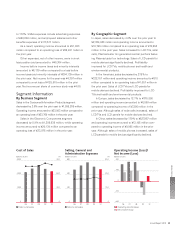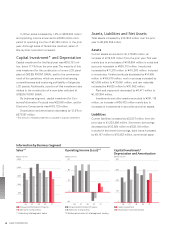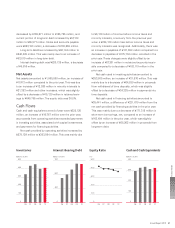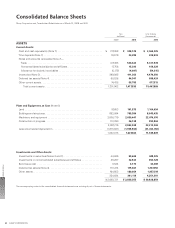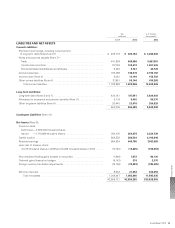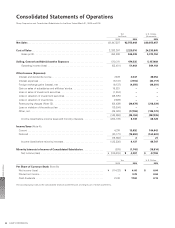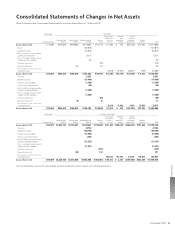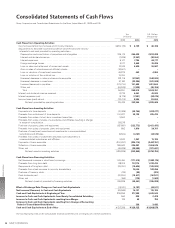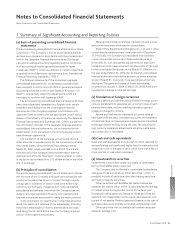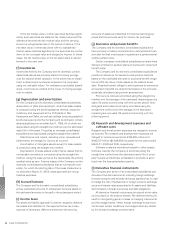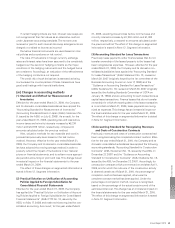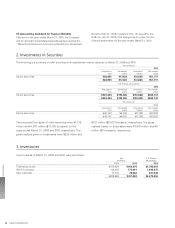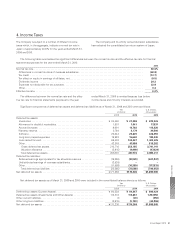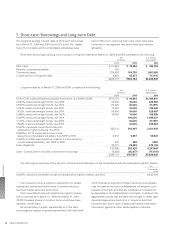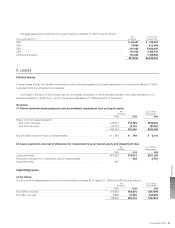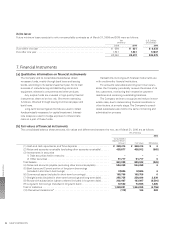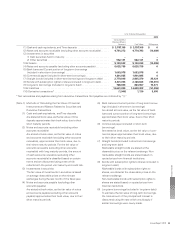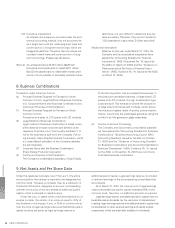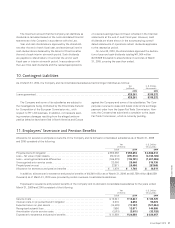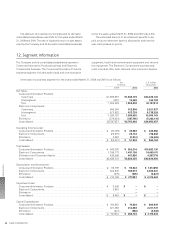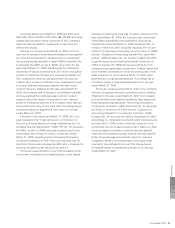Sharp 2010 Annual Report Download - page 51
Download and view the complete annual report
Please find page 51 of the 2010 Sharp annual report below. You can navigate through the pages in the report by either clicking on the pages listed below, or by using the keyword search tool below to find specific information within the annual report.
If certain hedging criteria are met, interest rate swaps are
not recognized at their fair values as an alternative method
under Japanese accounting standards. The net amounts
received or paid for such interest rate swap arrangements are
charged or credited to income as incurred.
Derivative financial instruments are used based on inter-
nal policies and procedures on risk control.
The risks of fluctuations in foreign currency exchange
rates and interest rates have been assumed to be completely
hedged over the period of hedging contracts as the major
conditions of the hedging instruments and the hedged items
are consistent. Accordingly, an evaluation of the effectiveness
of the hedging contracts is not required.
The credit risk of such derivatives is assessed as being
low because the counter-parties of these transactions have
good credit ratings with financial institutions.
(m) Changes in accounting methods
(1) Standard and Method for Measurement of
Inventories
Effective for the year ended March 31, 2009, the Company
and its domestic consolidated subsidiaries have applied the
“Accounting Standard for Measurement of Inventories”
(Accounting Standards Board of Japan (ASBJ) Statement No.
9, issued by the ASBJ on July 5, 2006). As a result, for the
year ended March 31, 2009, operating loss and loss before
income taxes and minority interests increase by ¥5,274
million and ¥12,919 million, respectively, compared to
amounts calculated under the previous method.
Also, valuation methods for raw materials and work in
process had previously been based on the last invoice
method. However, effective for the year ended March 31,
2009, the Company and its domestic consolidated subsidiar-
ies have adopted the moving average method in order to
properly reflect the impact of fluctuations in raw material
prices on financial statements, and to achieve more appropri-
ate periodic accounting of profit and loss. This change has an
immaterial impact on the financial statements for the year
ended March 31, 2009.
The effect of these changes on segmented information is
stated in Note 12. Segment Information.
(2) Practical Solution on Unification of Accounting
Policies Applied to Foreign Subsidiaries for
Consolidated Financial Statements
Effective for the year ended March 31, 2009, the Company
has applied the “Practical Solution on Unification of Account-
ing Policies Applied to Foreign Subsidiaries for Consolidated
Financial Statements” (ASBJ PITF No. 18, issued by the
ASBJ on May 17, 2006) and made revisions required for con-
solidated accounting. As a result, for the year ended March
31, 2009, operating loss and loss before income taxes and
minority interests increase by ¥1,804 million and ¥1,922
million, respectively, compared to amounts calculated under
the previous method. The effect of this change on segmented
information is stated in Note 12. Segment Information.
(3) Accounting Standard for Lease Transactions
Previously, lease payments under finance leases that do not
transfer ownership of the leased property to the lessee had
been recognized as expenses. However, effective for the year
ended March 31, 2009, the Company and its domestic con-
solidated subsidiaries have applied the “Accounting Standard
for Lease Transactions” (ASBJ Statement No. 13, revised on
March 30, 2007 (originally issued by the 1st committee of the
Business Accounting Council on June 17, 1993)) and the
“Guidance on Accounting Standard for Lease Transactions”
(ASBJ Guidance No. 16, revised on March 30, 2007 (originally
issued by the Auditing Standards Committee of JICPA on
January 18, 1994)) and are accounting for such transactions as
capital lease transactions. Finance leases that do not transfer
ownership for which the starting date of the lease transaction
is on and before March 31, 2008, lease payments are recog-
nized as expenses. This change has an immaterial impact on
the financial statements for the year ended March 31, 2009.
The effect of this change on segmented information is stated
in Note 12. Segment Information.
(4) Accounting Standard for Recognizing Revenues
and Costs of Construction Contracts
Previously, revenues and costs of construction contracts had
been recognized using the completed-contract method. Effec-
tive for the year ended March 31, 2010, the Company and its
domestic consolidated subsidiaries have applied the following
accounting standards; “Accounting Standard for Construction
Contracts” (ASBJ Statement No. 15, issued by the ASBJ on
December 27, 2007) and the “Guidance on Accounting
Standard for Construction Contracts” (ASBJ Guidance No. 18,
issued by the ASBJ on December 27, 2007). Accordingly, for
construction contracts which commenced on and after April 1,
2009, and for which the outcome of the construction activity
is deemed certain as of March 31, 2010, the percentage-of-
completion method has been applied, otherwise the
complete-contract method has been applied. Under the
percentage-of-completion method, revenue is recognized,
based on the percentage of the actual costs incurred of the
estimated total cost. This change has an immaterial impact on
the financial statements for the year ended March 31, 2010.
The effect of this change on segmented information is stated
in Note 12. Segment Information.
Financial Section
Annual Report 2010 49


